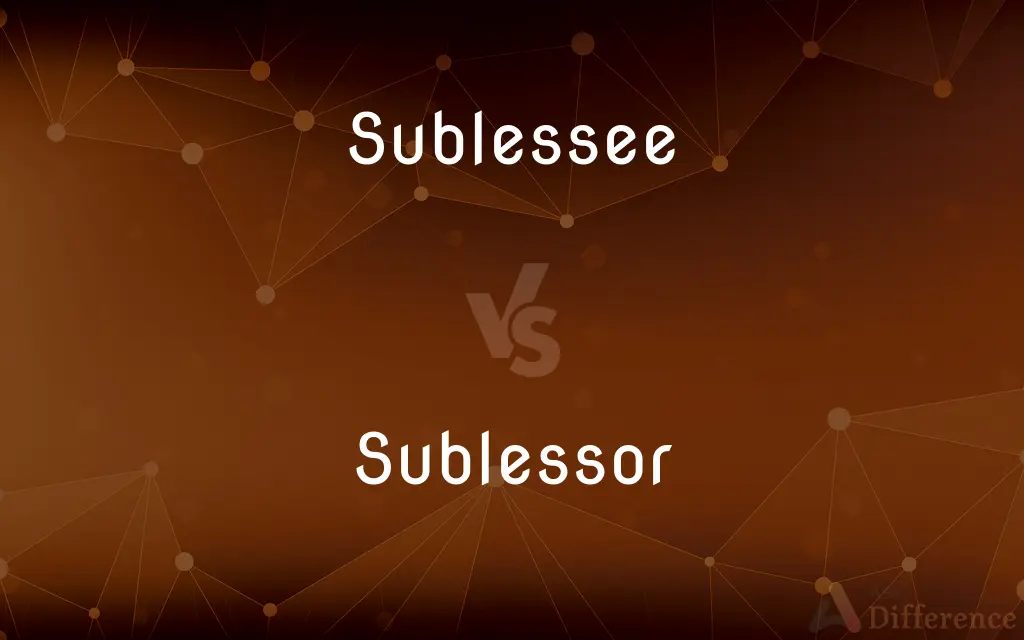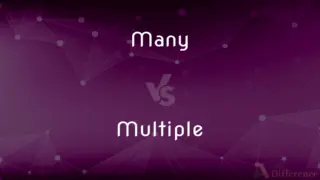Sublessee vs. Sublessor — What's the Difference?
Edited by Tayyaba Rehman — By Maham Liaqat — Updated on March 25, 2024
A sublessee is a tenant who rents from a sublessor, who is the original tenant leasing from the property owner, each with distinct rights and responsibilities.

Difference Between Sublessee and Sublessor
Table of Contents
ADVERTISEMENT
Key Differences
A sublessee enters into an agreement to rent property from a sublessor, who is already leasing the property from the owner. This creates a hierarchical lease structure, where the sublessor acts as a middleman between the property owner and the sublessee.
While the sublessor retains the primary lease agreement with the property owner, including the responsibility for rent and maintenance, the sublessee typically has fewer responsibilities, mainly to the sublessor and not directly to the property owner.
The sublessee's rights are usually more limited than those of the sublessor, particularly regarding lease terms and property use. On the other hand, the sublessor must ensure their actions, and the sublease agreement itself, comply with the original lease.
Sublessees often benefit from shorter lease terms and possibly lower rent, attractive for temporary or urgent housing needs. Sublessors, however, can mitigate their rental costs or fill a temporary vacancy without breaking their lease.
Regarding legal responsibilities, the sublessor remains liable to the property owner for rent and any damages, while the sublessee is liable to the sublessor, establishing a dual layer of accountability in the rental agreement.
ADVERTISEMENT
Comparison Chart
Definition
Tenant renting from an existing tenant (sublessor)
Original tenant leasing property from the owner
Relationship
Has a direct relationship with the sublessor
Has relationships with both the property owner and sublessee
Legal Obligations
Obligations primarily to sublessor
Obligations to both the property owner and sublessee
Lease Terms
Usually subject to terms set by the sublessor within original lease
Bound by the original lease terms with the property owner
Purpose
Often seeks temporary or flexible leasing options
Aims to mitigate rental costs or fill a vacancy temporarily
Compare with Definitions
Sublessee
An individual occupying leased property under a subtenant arrangement.
The sublessee agreed to pay rent directly to the sublessor.
Sublessor
The original tenant in a sublease arrangement.
As a sublessor, Mia was responsible for collecting rent from her sublessee.
Sublessee
Someone who enters into a rental agreement with a current tenant.
The sublessee found the arrangement ideal for the short-term job relocation.
Sublessor
Someone who retains the primary lease while creating a sublease for another.
The sublessor needed the landlord’s permission before proceeding.
Sublessee
A person who leases property from a tenant rather than the property owner.
Jane became a sublessee when she rented a room in Tom's apartment.
Sublessor
A tenant who leases out their rented property to another tenant.
Alex became a sublessor to help cover his rent while studying abroad.
Sublessee
A secondary tenant under a sublease agreement.
As a sublessee, Mark had to comply with both the sublease and the original lease terms.
Sublessor
A tenant acting as a landlord to a sublessee.
The sublessor ensured the sublease complied with the property owner’s regulations.
Sublessee
A tenant who does not hold a direct lease agreement with the property owner.
Being a sublessee allowed Lisa to avoid a long-term lease commitment.
Sublessor
A leaseholder who offers part or all of their leased property to a subtenant.
The sublessor provided a copy of the original lease to ensure transparency.
Sublessee
(property law) subtenant.
Sublessor
(property law) A tenant (or lessee) that grants a sublease; one who sublets.
Sublessee
A holder of a sublease.
Common Curiosities
What is a sublessee?
A sublessee is a person who rents property from an existing tenant, known as a sublessor.
Can a sublessee deal directly with the property owner?
No, a sublessee typically interacts with and has obligations to the sublessor, not directly to the property owner.
What responsibilities does a sublessor have?
A sublessor is responsible for the property to the owner and must ensure the sublessee complies with lease terms.
Is a sublease agreement always legal?
A sublease is legal if it complies with the original lease terms and, usually, if the property owner consents to it.
How do the rights of a sublessee compare to those of the sublessor?
A sublessee’s rights are more limited, focused on the agreement with the sublessor, while the sublessor retains rights and obligations from the original lease.
Can a sublessor terminate a sublease early?
This depends on the terms of the sublease agreement and the original lease; typically, both agreements outline termination conditions.
Can a sublease exceed the term of the original lease?
No, a sublease cannot extend beyond the term of the sublessor’s original lease with the property owner.
What are common restrictions in sublease agreements?
Restrictions often mirror the original lease, such as no pets or alterations, and may include limits set by the sublessor.
How is rent typically determined in a sublease?
Rent is agreed upon between the sublessor and sublessee, sometimes influenced by the original lease’s terms and current market rates.
Who is a sublessor?
A sublessor is an original tenant who leases their rented property or a part of it to another person, the sublessee.
Do sublessees need to pay a security deposit?
Often, yes, sublessees may need to pay a security deposit to the sublessor as part of the sublease agreement.
What happens if a sublessee damages the property?
The sublessor may be liable to the owner for damages, but can seek recovery from the sublessee according to their sublease agreement.
What is the primary reason someone becomes a sublessor?
The primary reasons include mitigating rental costs or filling a temporary vacancy without breaking the original lease.
How can a sublessee ensure their rights are protected?
By thoroughly reviewing the sublease agreement, ensuring it’s fair and compliant with the original lease, and possibly seeking legal advice.
Can a sublessee sublet the property to another person?
Usually, no. Subleasing again would require explicit permission from both the sublessor and the property owner, and is often prohibited.
Share Your Discovery

Previous Comparison
Pun vs. Joke
Next Comparison
Many vs. MultipleAuthor Spotlight
Written by
Maham LiaqatEdited by
Tayyaba RehmanTayyaba Rehman is a distinguished writer, currently serving as a primary contributor to askdifference.com. As a researcher in semantics and etymology, Tayyaba's passion for the complexity of languages and their distinctions has found a perfect home on the platform. Tayyaba delves into the intricacies of language, distinguishing between commonly confused words and phrases, thereby providing clarity for readers worldwide.















































